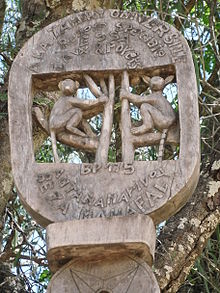Beza Mahafaly Reserve
| Beza Mahafaly Special Reserve | |
|---|---|
|
IUCN category IV (habitat/species management area)
|
|
 |
|
|
Location of Beza Mahafaly Reserve
|
|
| Location | Southwest Madagascar |
| Nearest city | Toliara |
| Coordinates | 23°40′S 44°36′E / 23.667°S 44.600°ECoordinates: 23°40′S 44°36′E / 23.667°S 44.600°E |
| Area | 1,433 acres (5.80 km2) |
| Established | 1978 |
| Governing body | Parcs Nationaux Madagascar -ANGAP |
The Beza Mahafaly Reserve is a nature reserve in Madagascar 35 kilometres (22 mi) northeast of Betioky Sud. The reserve also provides training and research opportunities. It consists of a fenced gallery forest, approximately 100 hectares (250 acres), separated by 8 kilometres (5 mi) from a 520-hectare (1,300-acre) gallery of arid spiny forest. The reserve has a museum that is open to tourists.
Tree species featured in the two galleries include tamarind trees and Madagascar ocotillo, among many others. Animals residing in the galleries include four species of lemurs, four species of tenrecs, 17 species of saurians, 12 species of snakes, two species of tortoises and, in season, the Nile crocodile. There are over 100 species of birds.
The Reserve was founded in 1975, when community leaders formed a partnership with the University of Madagascar (now University of Antananarivo), Washington University, and Yale University aiming to protect the forest. It has been a centre for research and education since 1978, and the Bezà Mahafaly Monitoring Team of local researchers began work in 1995.
International researchers, supported by the Monitoring Team, maintain long-term studies of the reserve's wildlife. For example, Verreaux's sifaka and the ring-tailed lemur have been the subjects of collaborative research by Malagasy and US researchers for over 25 years. During this period, hundreds of specimens have been observed in the field, with individual tagging, anatomical measurement, and genetic and hormone sampling helping researchers to understand their behavior, physiology, mating strategies, and demography.
...
Wikipedia

